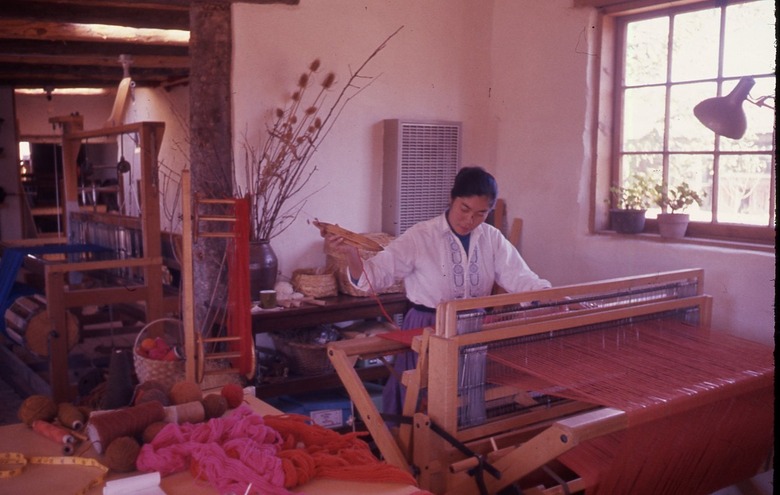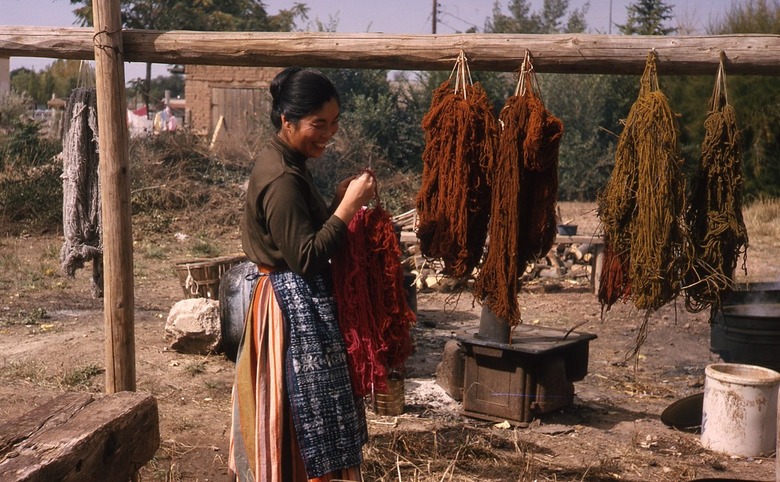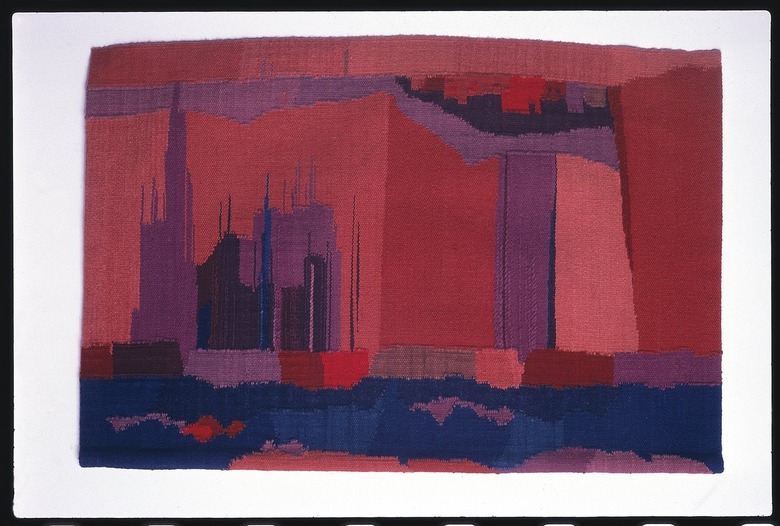The Often Overlooked, But Impactful, Work Of Artist Alice Kagawa Parrott
It's relatively easy to find handmade items today, whether you shop in person or browse through online retailers like Etsy. Search "textile wall art" and you'll get 40,000 results on the site. More sizable brands like West Elm, for instance, have also been collaborating with creators like Virginia Sin, owner of home goods brand SIN, making it easier for people to find handcrafted items from creatives across disciplines.
But for many women artists working in craft mediums in the 1960s and '70s, there was a number of challenges when it came to both mastering their craft and getting their work seen. There is still a number of women artists whose work and contributions haven't been fully highlighted. Japanese American artist Alice Kagawa Parrott made her own way in the 1950s, learning the art of weaving and ceramics from mentors as well as her own travels. Her journey wasn't linear.
According to an oral history interview with the artist from July 2005 via the Archives of American Art, Smithsonian Institution, Parrott attended Hawaii Mission Academy as a teen. The Seventh-day Adventist school, she says, didn't allow students to wear makeup or watch movies. She rebelled against that environment, sneaking out to watch films with a friend.
After attending a business college for one year, which she found "very boring," Parrott headed to the University of Hawaiʻi at Mānoa, where she studied home economics. Her curriculum included the opportunity to take an art class; soon, she decided to major in weaving and minor in ceramics, focusing on areas like upholstery, fabrics, and drapery. Artist and professor Claude Horan, who founded the ceramics department at the university in 1947, urged Parrott to apply for a master's degree in art.
Parrott says her parents "didn't know anything about art," making her decision a significant one. "My mother thought I was just going to school and playing with mud and stuff like that," Parrott said in the oral interview. Still, her parents decided to help pay her tuition when she was admitted to Cranbrook, an educational institution in Michigan that would host a number of important figures in craft, art, design, and architecture. Parrott worked in the dining area to help pay for fees. Her plane ride to California from Hawaii was the first time she ever got on a plane; from there, she took the train to Michigan to start a new chapter. She studied with significant names like Finnish American designer Marianne Strengell and ceramicist Maija Grotell.
As her process and style in both textiles and ceramics evolved, Parrott began to use native materials from Hawaii. Her use of bright hues can also be traced back to her homeland, specifically "the colors and flowers and the sky and the ocean." Her colors feel contemporary today, pulling in the viewer with their saturation.
"[The artworks'] vibrant color and geometric designs seem almost timeless, perhaps because they're relatively minimalist and don't seem kitschy in retrospect," design and culture writer Sarah Archer tells Hunker.
Parrott's contributions and influence are also captured in With Eyes Opened: Cranbrook Academy of Art Since 1932, published in 2020 by the institution. The text looks at artists who made their mark on the campus, calling attention to "those voices — especially women and artists of color — who have added immensely to the fields of art and craft, in particular," as the book's description states.
According to the volume, Parrott "crafted mats and screens using coconut bark, matchstick bamboo, hau fibers, and other materials from Hawaii" during her time at Cranbrook. She also focused her master's thesis on "strategies for fostering a handweaving industry that catered to the tourist trade" in her homeland. A photo in the book shows Parrott smiling at a loom, her hands in the midst of creating a new piece.
The artist completed her MFA in weaving at Cranbrook in 1954, and she soon took a job as a professor at the University of New Mexico. She got creative with her materials in order to stay within budget constraints for the class.
"It was like $50 for materials, so we all went out together and found native materials to dye with, and then we looked around for clay in the hills around La [Bajada], among other places, for the clay and things like that," Parrott said.
Parrott is one of many women artists, particularly in craft and art history, who explored the limits and possibilities of textiles and ceramics. Archives of Parrott's life as well as craft histories give us more insight. Her work, for instance, was featured in the 2015 National Museum of Women in the Arts exhibition "Pathmakers: Women in Art, Craft, and Design, Midcentury and Today."
"The reason I see Alice Kagawa Parrott as a beacon of promise is that she made her own path resiliently and independently while maintaining friendships and connections with her classmates at Cranbrook — and perhaps the fact that she prioritized her family and local networks makes me think she is as estimable as those who conquered New York City or worked their way to positions in higher education," Ezra Shales, professor of art history and a guest curator for the NMWA exhibition, tells Hunker. "Her ponchos commissioned by the Santa Fe Opera embody that complexity, as they were seen by an international audience — a local production that was certainly fed by global enthusiasms and contacts."
Parrott visited Navajo reservations and traveled to Mexico, gaining more insight on weaving techniques. She spent a summer in California studying with ceramicist Marguerite Wildenhain before settling in Santa Fe in 1956. In her four-room home, she opened her own shop; the living room showcased her goods (mostly "upholsteries and draperies and also gift items," she explains in the oral history interview) while the rest of the space served as her workshop and living area. Through a grant, she traveled to Mexico and Guatemala, learning more about indigo and cochineal dyeing; she also went to India to spend time with textile designer Kinnari Lakhia.
This richness of experience — across geographies, modes of making, and aesthetics — fed her work. In the 1970s, Kagawa achieved a number of artistic accomplishments, including a commission to create a woven version of the county seal of Maui, specially made for the County Council Chamber in Wailuku.
"I think for artists working in any craft medium, depending on their ambitions, there's always a sense of needing to be careful where status and context are concerned; this idea that 'working small,' as in making cups or earrings or purses, takes away from what credibility they may have as a contemporary artist in a fine art or sculptural context," says Archer. "Alice made things like woven fabric eyeglass cases and monumental works of art. I think she managed to navigate this terrain pretty deftly, working in modalities that inspired her, at a small scale when she wanted to, but not shying away from more complex and involved projects."
More recently, the artist's work was on display at the Los Angeles County Museum of Art (LACMA) exhibition "Scandinavian Design and the United States: 1890-1980" in 2022. The exhibition included a section on teachers and their students that featured Parrott's 1968 linen, wool, and wood piece Bird Cage, displayed near the work of some of her teachers, like Strengell and Grotell. According to the exhibition catalog, Strengell introduced Parrott and fellow classmate and artist Toshiko Takaezu to rya, described as "a long-pile rug typically made of wool."
Archer has noticed a renewed interest in Parrott's work. Shales, on the other hand, says he first discovered Parrott while reading a Craft Horizons article about 1960s artists who were acclaimed during their time but have received little attention today. That road lead him to learning more about Parrott's work.
"Such research is humbling, as you realize how much you have to learn and how many artists — and especially women and artists of color — have obscure contributions outside the canon of art history that bear reconsideration," said Shales.
Parrott passed away in 2009. While many women artists of the 1960s and 1970s in craft mediums aren't as well known as major male figures, Parrott's story is proof that there's still so much to learn. The artist's passion and curiosity can still be felt in her work today.




